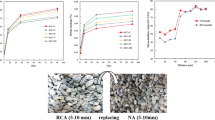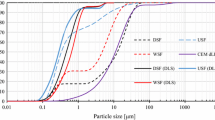Abstract
The fresh and hardened properties of self-compacting concrete (SCC) depend on number of factors such as paste composition, paste content, aggregate content, aggregate gradation etc. In the present investigation, the influence of the packing density of aggregates on the properties of SCC was evaluated. Experiments were conducted to measure the packing density for different combinations of aggregates precisely. A ternary packing diagram (TPD) was developed based on the packing density of measured and interpolated data. Considering the limitations in generalising the TPD and the difficulty involved in adopting mathematical models for aggregates, an attempt was made to establish a simple method for the selection of the combination of aggregates resulting in maximum packing density from the particle size distribution of aggregates (represented by the Coefficient of uniformity—C u). Further, studies were extended to investigate the effect of aggregate packing density on fresh and hardened SCC properties. The results indicate that for a constant paste volume and paste composition, with increase in packing density of aggregates, the fresh properties and the compressive strength of SCC were improved positively. An attempt was also made to identify the influence of 10 different proportions of aggregates having the same packing density on the properties of SCC. The results indicate that at the same aggregate packing density, the fresh concrete properties were influenced significantly by the choice of the aggregate combination, while there was little or no influence on the hardened properties. Furthermore, the experimental data obtained was used for supplementary validation of the existing model (compressible packing model) for predicting the packing density and the fresh behaviour of SCC.









Similar content being viewed by others
References
Andreasen AHM, Andersen J (1930) Uber die beziehung zwischen kornabstufung und zwischenraum in produkten aus losen kornern (mit einigen experimenten). Kolloid Z 50:217–228
Goltermann P, Johansen V, Palbol L (1997) Packing of aggregates: an alternative tool to determine the optimal aggregate mix. ACI Mater J 94(5):435–443
Glavind M, Pedersen EJ (1999) Packing calculations applied for concrete mix design. In: Proceedings of creating with concrete, University of Dundee, pp 1–10
Johansen V, Andersen PJ (1991) Particle packing and concrete properties. Material Science of Concrete II. The American Ceramic Society, Westerville, pp 111–147
Joisel A (1952) Composition des betons hydrauliques. Ann IITBTP 58:992–1065
Fuller WB, Thompson SE (1907) The laws of proportioning concrete. Trans Am Soc Civ Eng 59:67–172
Senthil Kumar V, Santhanam M (2003) Particle packing theories and their application in concrete mixture proportioning: a review. Indian Concr J 77:1324–1331
Romagnoli M, Siligardi C (2004) Comparison of models for dense particle packing. In: Proceedings of Congresso, AIMAT Ancona, 29 Giugno-2, Luglio
Dewar JD (1999) Computer modelling of concrete mixtures. E & F N Spon, London
De Larrard F (1999) Concrete mixture proportioning—a scientific approach. E and FN Spon, London
Jones MR, Zheng L, Newlands MD (2002) Comparison of particle packing models for proportioning concrete constituents for minimum voids ratio. Mater Struct 35:301–309
Andersen PJ (1990) Control and monitoring of concrete production. PhD Thesis, Academy of Technical Sciences, The Technical University of Denmark
Standish N, Yu AB (1987) Porosity calculations of ternary mixtures of particles. Powder Technol 49(3):249–253
Ridgway K, Tarbuck KJ (1968) Particulate mixture bulk densities. Chem Proc Eng 49:103–105
IS 12269 (2004) Specification for 53 grade ordinary portland cement. Bureau of Indian Standards
ASTM 127 (2001) Standard test method for density, relative density (specific gravity), and absorption of coarse aggregate. American Society for Testing and Materials Standards, West Conshohocken
ASTM C 128 (2001) Standard test method for density, relative density (specific gravity), and absorption of fine aggregate. American Society for Testing and Materials Standards, West Conshohocken
ASTM C 29 (2001) Standard test method for bulk density (Unit Weight) and voids in aggregate. American Society for Testing and Materials Standards, West Conshohocken
IS 2386 (2002) Methods of test for aggregates in concrete—Part I: particle size and shape. Bureau of Indian Standards, New Delhi
Fasshauer GE (2007) Meshfree approximation methods with MATLAB. World Scientific Company, River Edge
McGeary RK (1961) Mechanical packing of spherical particles. J Am Ceram Soc 44(10):513–522
Hazen A (1892) Some physical properties of sands and gravels. Massachusetts State Board of Health. Annual Report, pp 539–556
Nanthagopalan P, Santhanam M (2009) Experimental investigations on the influence of paste composition and content on the properties of self-compacting concrete. Construct Build Mater 23:3443–3449
ASTM C 1621 (2006) Standard test method for passing ability of self-compacting concrete by J ring. American Society for Testing and Materials Standards, West Conshohocken
De Larrard F (2009) Concrete optimisation with regards to packing density and rheology. In: Proceedings of 3rd International RILEM symposium on Rheology of cement suspensions such as fresh concrete, Iceland, pp 1–8
Acknowledgments
The authors wish to express their sincere thanks to Dr. F. de Larrard, LCPC Centre de Nantes, France for giving insights about the CPM model and for having technical discussions. The authors extend their thanks to Dr. Antony Vijesh, Assistant Professor, Department of Mathematics, Indian Institute of Technology Indore, India for his help regarding the interpolation of experimental data.
Author information
Authors and Affiliations
Corresponding author
Rights and permissions
About this article
Cite this article
Nanthagopalan, P., Santhanam, M. An empirical approach for the optimisation of aggregate combinations for self-compacting concrete. Mater Struct 45, 1167–1179 (2012). https://doi.org/10.1617/s11527-012-9824-3
Received:
Accepted:
Published:
Issue Date:
DOI: https://doi.org/10.1617/s11527-012-9824-3




